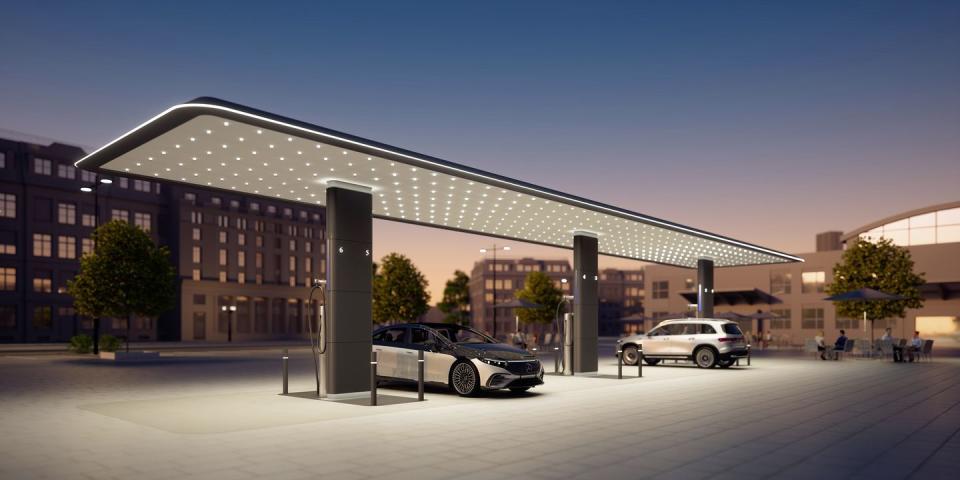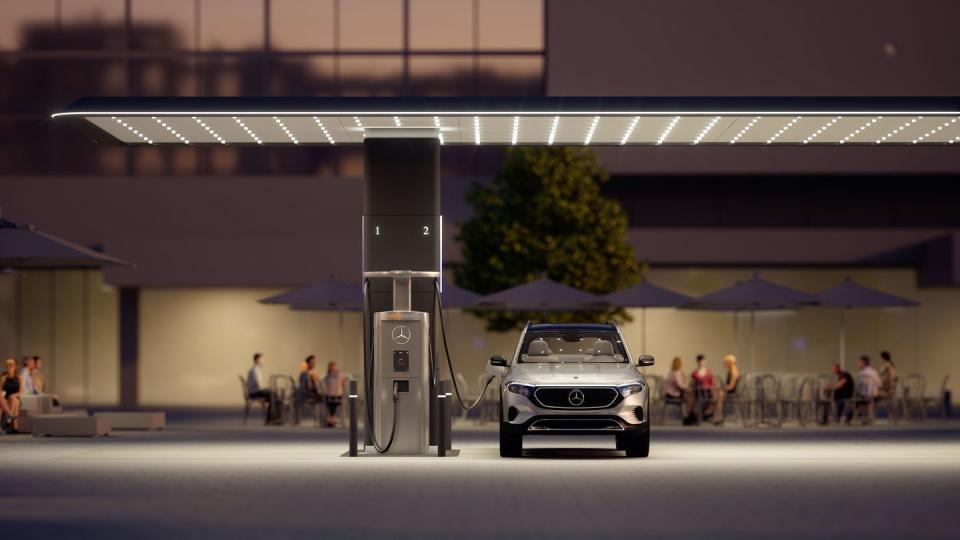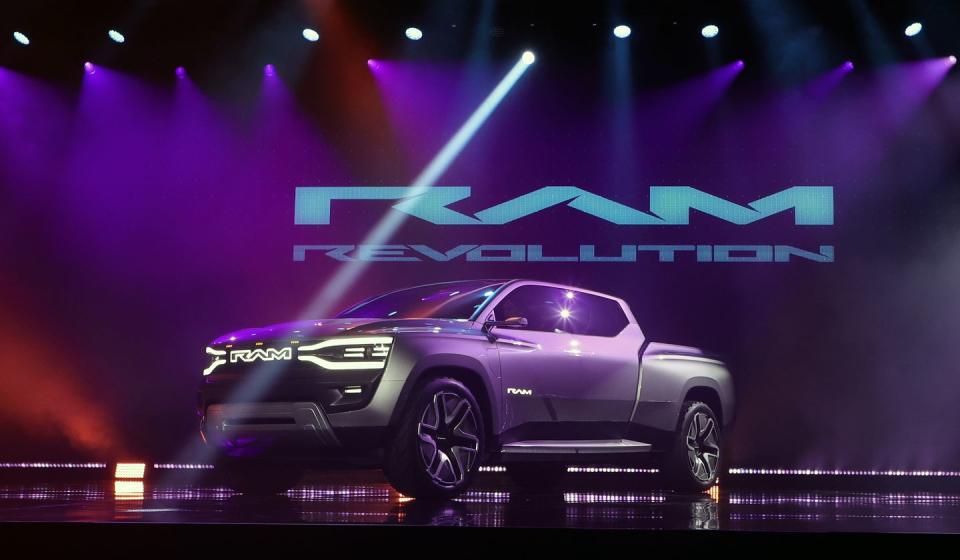More Car Companies Are Finally Copying the One Thing Tesla Does Right

Auto manufacturers are entering an arms race of electrification, hawking concept EVs with increasingly luxurious cabins, self-driving driving assistance features, and gargantuan batteries capable of unnecessarily long driving distances. These defining features help brands stand out in a sea of compact crossover EVs, but one thing is common between them: the public charging experience sucks. At the Consumer Electronics Show 2023, some manufacturers announced plans to change that.
EV adoption is expected to grow to 29.5 percent of all new car sales in 2030, up from roughly 3.4 percent in 2021, according to electric vehicle industry consultancy EV Adoption.
But explosive growth has a drawback – it creates more demand for the paltry public charging infrastructure available in most of the U.S. As a result, Mercedes-Benz and Stellantis are angling to get ahead of the problem by developing their own charging networks tailored toward its customers.
Drivers arriving at broken public charging stations are an increasingly common story on social media. Although most EV owners refuel at their home, more apartment dwellers are opting for EVs despite not having a dedicated charging spot, and most drivers need to venture beyond their usual haunts once in a while and into areas where stations may be scarce. Worse, the few that are available may be broken when they get there.
These charging fails aren’t just bad for owners – they could become cautionary tales that sour future buyers on a technology into which automotive manufacturers are pouring billions of dollars. One way to protect that investment is to take control of the public charging experience.
Can charging your car be a luxury experience?
Mercedes-Benz Chief Technology Officer Markus Schäfer announced at CES 2023 plans for the company to open a network of more than 400 sites in North America with 2,500 charging stations by the end of the year. Like Tesla’s Supercharger network, the charging station technology platform will be closely integrated with the brands’ telematics platform. This system design enables the company to calculate stopping points along long-distance travel routes and book a reservation based on when the vehicle expects the vehicle to arrive. Should the driver get help up in traffic, the navigation system can reroute them to a station that has availability and the correct charging speed required to get them to their destination.
Schäfer says the Mercedes-Brand said the company needs to deliver more than just power; it will have to offer an elevated experience.
“It’s not going to be next to a dumpster,” joked Schäfer about potential locations. “It’s not going to be in the backyard of a supermarket.”

Sites would need to be in safe, and well-lit locations and near amenities that its well-heeled clientele prefer, such as cafes or high-end shopping stores. “We want to make a difference from what others are doing in this space,” he explained.
While reservations seem like an obvious level of service befitting vehicles with price tags hovering around $100,000, this differentiator may introduce new problems for an already stressful process. After all, there’s nothing luxurious about arriving at a reserved charging space to find it already occupied, and confronting another driver is usually a less-than-premium experience.
But not every detail has been finalized in this new product, and the company’s network developers are exploring a range of solutions to enforce reservations, including physical barriers to prevent people from entering a booked charging space and imposing high idle fees to ensure cars vacate the space in time for the next reservation.
Seeding an infrastructure desert
Stellantis is also creating a charging station network, but it grapples with an additional problem: rural America–where many full-size truck buyers dwell.
Electrical infrastructure in rural areas is less robust than what’s found in major metropolitan areas. Direct Current fast charging stations that can deliver speeds of hundreds of miles per hour of charge (a Taycan on a fast charger has been clocked at up to 14 miles per minute) require three phase power infrastructure, but communities outside of major metro areas are largely supported by older single-phase grids. Upgrading the old utility infrastructure can cost hundreds of thousands of dollars that communities often don’t have, which means that when the new energy-hungry full-size battery-powered trucks roll off the assembly lines, drivers won’t have anywhere to charge quickly.
To solve this problem, the U.S. government has earmarked $2.5 billion for the Discretionary Grant Program for Charging and Fueling Infrastructure in rural areas, but that program may not change things fast enough to support fast rising EV demand. It doesn’t help that long lead times for upgrading the transformer sometimes makes the operator eligible for state or federal grants that have timeline requirements. That it’s up to the manufacturer to step in and fix this problem seems to be a sore point for Stellantis CEO Carlos Tavares.

The company’s electrification strategy requires its dealerships to install Direct Current (DC) fast-charging stations for their upcoming EVs, although no formal name for the EV network has been announced. The move is expected to be costly for dealerships that want to comply with the brand’s requirements. A partnership with Edge EV, a U.S. manufacturer of solid state digital converters, may help reduce cost and speed the initiative.
Edge EV builds equipment that sits between a power meter and a DC fast charging station, and converts single-phase power coming out of the meter into three-phase power for fast-charging stations. This new product means a dealership may be able to save money if it chooses to sell EVs. Compared to what Mercedes-Benz has in its sights, Stellantis and Edge's plans just isn’t as brand-defining a move.
“Infrastructure is not our core business, or even our responsibility to create infrastructure. We supply mobility devices,” said Tavares at a roundtable event following his keynote speech. “If we invest in infrastructure, it’s to the detriment or development of other technologies.”
However seemingly reluctantly made, its plans will play an important role for the industry by seeding these energy infrastructure deserts and bringing these new electrical powertrains within easier reach of early battery-electric truck adopters.
A fragmented system
Creating a network is one thing, but maintaining it is another, and only Tesla seems to be getting it right. Broken stations, wrong hours, and expensive rates are just some of the unpredictable experiences customers outside of the Supercharger networks face. That could be because chargers have mainly been considered perks or amenities rather than mission critical infrastructure. As a result, operators hosting stations may not monitor systems as closely as necessary or notified the manufacturer for repairs. However, faster-than-expected EV adoption has made the flaws in this system clear, and ChargePoint has fixed them.
“I think the industry is really working through uptime reliability network consistency in terms of the hours of operation that a station might have, and we're very aggressively working with operators of these stations to make sure that their description of their chargers are accurate, and we're offering them service plans so that we can help monitor and dispatch repair,” says Bill Loewenthal, Chief Product Office for ChargePoint.
Part of its plan to improve station operation uptime is its new Express Plus system, which is more modular and uses components, such as compute modules and cables, that can be sourced and replaced quickly by general technicians rather than specialist electricians. New remote monitoring of the stations will help identify malfunctioning chargers and rapidly dispatch maintenance.
But whether or not these enormous investments into energy infrastructure be enough to support this rapidly growing industry are enough or will come soon enough isn’t clear. Each network probably will almost certainly require its own membership, have its own app, and different charging speeds, which are problems that drivers of fossil-fuel-powered vehicles don’t have to face.
You Might Also Like

 Yahoo Autos
Yahoo Autos 